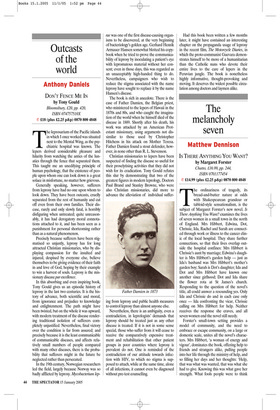Outcasts of the world
Anthony Daniels
DON’T FENCE ME IN by Tony Gould Bloomsbury, £20, pp. 420, ISBN 074757510X ✆ £18 (plus £2.25 p&p) 0870 800 4848 The leprosarium of the Pacific islands in which I once worked was situated next to the Mental Wing, as the psychiatric hospital was known. The lepers derived considerable pleasure and hilarity from watching the antics of the lunatics through the fence that separated them. This taught me an unedifying principle of human psychology, that the existence of people upon whom one can look down is a great solace in misfortune, no matter how grievous.
Generally speaking, however, sufferers from leprosy have had no one upon whom to look down. They have been outcasts, cruelly separated from the rest of humanity and cut off even from their own families. Their disease, rarely and only slowly fatal, is horribly disfiguring when untreated; quite unreasonably, it has had derogatory moral connotations attached to it, and has been seen as a punishment for personal shortcoming rather than as a natural phenomenon.
Precisely because sufferers have been stigmatised so unjustly, leprosy has for long attracted Christian missionaries, who by displaying compassion for the insulted and injured, despised by everyone else, believe themselves to be giving evidence of their faith in and love of God, hoping by their example to win a harvest of souls. Leprosy is the missionary disease par excellence.
In this absorbing and even inspiring book, Tony Gould gives us an episodic history of leprosy in the last two centuries. It is the history of advance, both scientific and moral, from ignorance and prejudice to knowledge and enlightenment. The path might have been twisted, but on the whole it was upward, with modern treatment of the disease rendering traditional isolation of sufferers completely unjustified. Nevertheless, final victory over the condition is far from assured; and precisely because it is the least communicable of communicable diseases, and affects relatively small numbers of people compared with many other diseases, there is the probability that sufferers might in the future be neglected rather than persecuted.
In the 19th century, Norwegian researchers led the field, largely because Norway was so badly afflicted by leprosy. Mycobacterium lep rae was one of the first disease-causing organisms to be discovered, at the very beginning of bacteriology’s golden age. Gerhard Henrik Armauer Hansen somewhat blotted his copybook when he tried to prove the communicability of leprosy by inoculating a patient’s eye with lepromatous material without her consent; even in those days, this was regarded as an unacceptably high-handed thing to do. Nevertheless, campaigners who wish to reduce the stigma associated with the name leprosy have sought to replace it by the name Hansen’s disease.
The book is rich in anecdote. There is the case of Father Damien, the Belgian priest, who ministered to the lepers of Hawaii in the 1870s and 80s, and who caught the imagination of the world when he himself died of the disease in 1889. Shortly after his death, his work was attacked by an American Protestant missionary, using arguments not dissimilar to those used by Christopher Hitchens in his attack on Mother Teresa. Father Damien found a stout defender, however, in none other than R. L. Stevenson.
Christian missionaries to lepers have been suspected of finding the disease so useful for their proselytising activities that they did not wish for its eradication. Tony Gould refutes this slur by demonstrating that two of the greatest figures in modern leprology, Doctors Paul Brand and Stanley Browne, who were also Christian missionaries, did more to advance the alleviation of individual suffer ing from leprosy and public health measures to control leprosy than almost anyone else.
Nevertheless, there is an ambiguity, even a contradiction, in leprologists’ demands that leprosy should be treated just as any other disease is treated. If it is not in some sense special, those who suffer from it will cease to receive the comparatively expensive treatment and rehabilitation that other patient groups in poor countries where leprosy is prevalent do not. One is reminded of the contradiction of our attitude towards infection with HIV, to which no stigma is supposed to attach, while at the same time, alone of all infections, it cannot even be diagnosed without pre-test counselling. Had this book been written a few months later, it might have contained an interesting chapter on the propaganda usage of leprosy in the recent film, The Motorcycle Diaries, in which the proto-communist Guevara demonstrates himself to be more of a humanitarian than the Catholic nuns who devote their entire lives to the care of lepers in the Peruvian jungle. The book is nonetheless highly informative, thought-provoking and moving. It deserves the widest possible circulation among doctors and laymen alike.





















































 Previous page
Previous page